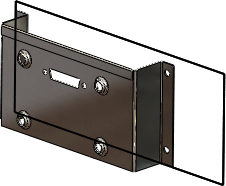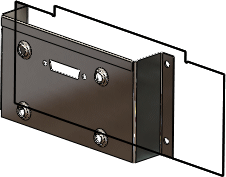Set the input values for determining the cost of manufacturing a sheet metal part from the Costing Task Pane.
Method
Choose a manufacturing method for the part.
Select a manufacturing method:
- Sheet Metal
- Machined Plate
|
Costing Template
You can choose default templates for each part type.
| Sheet Metal template |
Sets an existing sheet metal template. |
| Machining template |
Sets an existing machining template. |
| Launch Template Editor |
Opens the Costing Template Editor for creating or editing Costing templates. |
Material
| Class |
Sets the class of material based on the material that was set for the part. This is automatically selected if the part has a material already applied. |
| Name |
Sets the material based on the material of the part. This is automatically selected if the part has a material already applied. |
| Set Material |
Sets the SOLIDWORKS material properties of the part from your material Class and Name selections. |
| Thickness from template |
Displays the thickness value in the template that matches or is closest to the part thickness. If no thickness values in the template match the part thickness, the closest thickness value in the template is selected, and a warning icon  indicates that the thicknesses differ. indicates that the thicknesses differ. |
| Material cost |
Displays the cost defined for the material at the selected thickness in the template. If you override Material cost, the text box appears in yellow and you can click Reset to Template Default. |
Blank Size (Sheet Metal Method)
This is available in a sheet metal part when the selected method is Sheet Metal.
| Area to cost |
Sets an option to define the material usage. The area is displayed in the list. Select one of the following:
|
Bounding Box
|
Calculates the material based on the smallest rectangle in which the flat pattern can fit.
|
|
Flat Pattern Area
|
Calculates the minimum area required.
|
|
Custom Sheet Size
|
Sets a custom material size. This is helpful if you have a predetermined size of material in your shop.
|
|
Custom Area
|
Sets an area value.
|
|
| Offset |
(Available for Bounding Box and Flat Pattern Area.) Increases the Area to cost equally in all directions. For example, if you set Area to cost to Bounding box and you set Offset to 0.5, then all four sides of the rectangle are offset by 0.5. |
| Dimension |
(Available for Custom Sheet Size.) Sets the material length and width. |
| Area |
(Available for Custom Area.) Sets the material area. |
| Percent scrap |
|
| Final area |
Displays the total material area to use. |
| Preview in graphics area |
(Available for Bounding Box and Flat Pattern Area.) Displays a preview of the material used and how the offset affects the amount of material.
 |
| Bounding Box |
 |
| Flat Pattern Area |
|
Stock Body (Machined Plate Method)
This is available in a sheet metal part when the selected method is Machined Plate.
| Type |
Plate provides cost estimates based on manufacturing the part from a stock plate of material. The software assumes that a combination of 2D machining operations such as waterjet, laser, and plasma cutting, as well as milling and drilling operations are used to create the finished part. Through cuts and cuts that define the outside boundary of the part are cut using a 2D cutting method such as waterjet, laser, or plasma. Blind geometry, such as pockets, chamfers, or holes are cut using milling or drilling operations.
The stock plate size is determined by the largest surface area of the part. When you select Plate, the plate Size and Thickness from template are displayed. If no thickness values in the template match the part thickness, the closest thickness value in the template is selected, and a warning icon  indicates that the thicknesses differ. indicates that the thicknesses differ.
|
| Preview stock |
Shows a preview of the stock body in the graphics area. |
Quantity
| Total number of parts |
Quantity of parts to be manufactured. |
| Lot size |
Quantity of parts to be manufactured per run. |
Shop Rate
| Shop rate |
Sets a cost per hour to determine the cost of all manufacturing operations regardless of what machine is used. This value overrides all costs related to machines and labor in the machining template. Use Shop Rate if all you have is a shop rate for manufacturing processes. For example, a manufacturing vendor may tell you that their shop rate is $100/hour instead of telling you their rates for individual processes, such as milling and drilling. You can also set the Shop Rate as a default value in the machining template.
|
Markup/Discount
| Cost adjustment |
Adjusts the material cost or the total cost using a percentage factor. A negative value creates a discount, and a positive value creates a markup. For example, you can increase the cost by 15% of the material cost which gets added to the total cost. The 15% will reduce the cost with a negative percentage. Select one of the following:
|
% of Total Cost
|
Increases the cost of manufacturing based on a percentage of the total cost.
|
|
% of Material Cost
|
Increases the cost of manufacturing based on a percentage of the material cost.
|
Use this option if you get a discount on material or the total cost of a manufactured part. If you are a manufacturer, use this option to set your profit margin over your actual costs.
|
Estimated Cost Per Part
| |
Cost |
Displays the total estimated cost of manufacturing the part. The cost is constantly updated based on any changes you make. |
| |
Comparison |
Displays a bar chart for the Current and Previous costs or the Current and Baseline costs. If changes to the part decrease the cost, the Current bar is green and the % difference  is negative. If changes to the part increase the cost, the Current bar is red and the % difference is negative. If changes to the part increase the cost, the Current bar is red and the % difference  is positive. is positive. Click Set Baseline  to set a baseline cost for comparison. If you change the design later on, the cost is compared to the baseline cost. When you set a baseline cost, any changes to the part are considered Current and the difference is displayed. While the baseline price is set, the part is rotated, flattened, and refolded because the software is capturing images for the Costing report. to set a baseline cost for comparison. If you change the design later on, the cost is compared to the baseline cost. When you set a baseline cost, any changes to the part are considered Current and the difference is displayed. While the baseline price is set, the part is rotated, flattened, and refolded because the software is capturing images for the Costing report.
|
| |
Breakdown |
Displays the cost and percentage distributions for the major contributors of the total cost:
|
Material
|
Cost of the material based on the weight of the material used.
|
|
Manufacturing
|
Total processing cost, including cuts, bends, forming tools, and additional operations.
|
|
Markup or Discount
|
Adjustment specified in Markup/Discount.
|
|
 |
Generate Report |
Opens the Report Options dialog box where you can customize a report and export it as a Word document or as an Excel spreadsheet. |